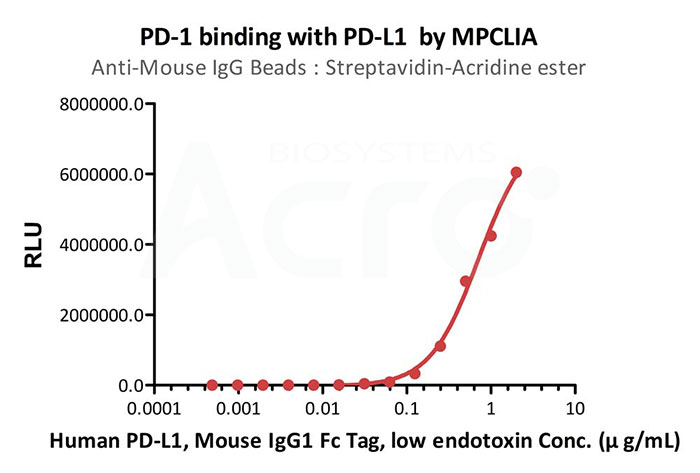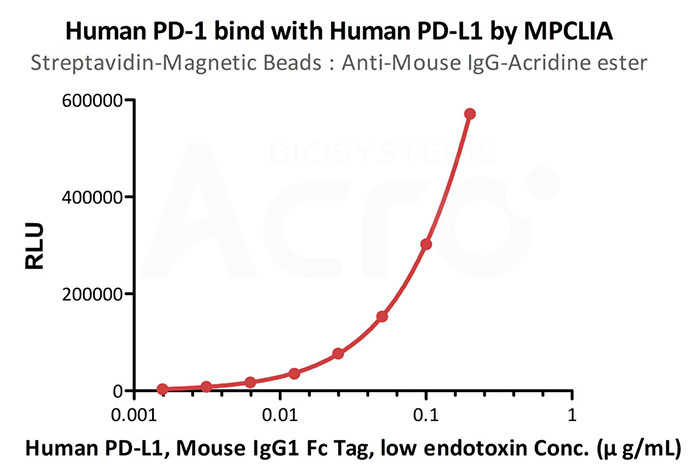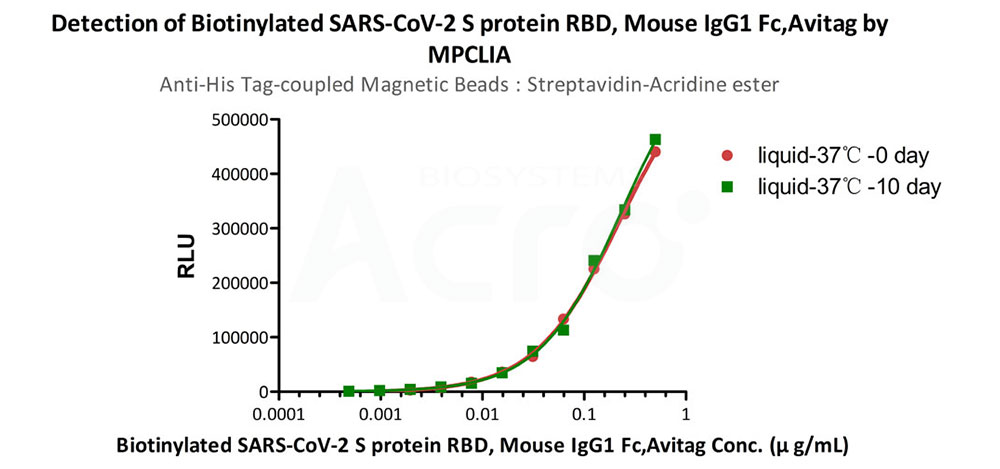 Request a FREE Sample of our FcRn Binding Kit!
Request a FREE Sample of our FcRn Binding Kit! Request a FREE Sample of our FcRn Binding Kit!
Request a FREE Sample of our FcRn Binding Kit!
 Limited Edition Golden Llama is here! Check out how you can get one.
Limited Edition Golden Llama is here! Check out how you can get one.  Limited Edition Golden Llama is here! Check out how you can get one.
Limited Edition Golden Llama is here! Check out how you can get one.
 Request a FREE sample of our GMP products!
Request a FREE sample of our GMP products!  Request a FREE sample of our GMP products!
Request a FREE sample of our GMP products!
> Reagents to Build Your Own Magnetic Particle Chemiluminescent Immunoassay (MPCLIA) 
Magnetic Particle (MP) Chemiluminescent Immunoassay (CLIA) is an analytical method that combines the flexibility of magnetic beads with the sensitivity and specificity of CLIA. Instead of immobilizing proteins or antibodies within the well plate, magnetic beads provide a significant increase to the sample contact surface area, capture efficiency, and automation capabilities. As such, MPCLIA is becoming frequently adopted in disease diagnostics, chemical reaction monitoring, and many other research fields.
Besides the use of magnetic beads as the base scaffold, the biggest deviation of MPCLIA from traditional ELISA is the detection through chemiluminescence. By utilizing a chemical reaction to excite substances like horseradish peroxidase (HRP) and acridinium ester(AE), photons are released that can be measured using a specialized chemiluminescence reader. In comparison, CLIA methods have often shown higher sensitivity, specificity, and linear ranges over traditional ELISA.
Chemiluminescence Detection Mechanism

Colorimetric (ELISA) Detection Mechanism

| Product type | Cat. No. | Product Description | Preorder/Order |
|---|

| Assay No. | Magnetic Beads | Sample 1 | Sample 2 | Marker | Substrate Solution |
|---|---|---|---|---|---|
| 1 | Protein A-coupled Magnetic Beads (Cat. No. MPC-A001) | Human Antibody | Biotinylated non-Fc tag protein | Streptavidin-Acridine ester (Cat. No. STN-NA114) | Substrate Solution(AE Marker) (Cat. No. ABK-001) |
| 2 | hFc tag protein | ||||
| 3 | Protein G-coupled Magnetic Beads (Cat. No. MPC-A002) | Human/Mouse Antibody | Biotinylated non-Fc tag protein | ||
| 4 | Fc tag protein | ||||
| 5 | Anti-His-coupled Magnetic Beads (Cat. No. MPC-A005) | His tag protein | Biotinylated non-His tag protein | ||
| 6 | Human antibody | Anti-Human IgG-Acridine ester (Cat. No. AHG-Y69) | |||
| 7 | hFc tag protein | ||||
| 8 | Anti-Mouse IgG-coupled Magnetic Beads (Cat. No. MPC-A003) | Mouse antibody | Biotinylated non-mFc tag protein | Streptavidin-Acridine ester (Cat. No. STN-NA114) | |
| 9 | mFc tag protein | ||||
| 10* | Mouse antibody | hFc tag protein | Anti-Human IgG-Acridine ester (Cat. No. AHG-Y69) | ||
| 11* | mFc tag protein | Human antibody | |||
| 12* | hFc tag protein | ||||
| 13 | Streptavidin-Magnetic Beads (recommended for MPCLIA) (Cat. No. MPC-A006) | Biotinylated non-hFc tag protein | Human antibody | ||
| 14 | hFc tag protein | ||||
| 15 | Biotinylated non-mFc tag protein | Mouse antibody | Anti-Mouse IgG-Acridine ester (Cat. No. AMG-S163) | ||
| 16 | mFc tag protein | ||||
| 17 | Anti-Human IgG-coupled Magnetic Beads (Cat. No. MPC-A004) | Human antibody | mFc tag protein | ||
| 18 | hFc tag protein | ||||
| 19* | hFc tag protein | Mouse antibody | |||
| 20* | Human antibody | Biotinylated non-hFc tag protein | Streptavidin-Acridine ester (Cat. No. STN-NA114) | ||
| 21* | hFc tag protein |

Immobilized 0.04 μg /Test of Biotinylated Human PD-1, Avitag,His Tag (recommended for biopanning) (Cat. No. PD1-H82E4) to the Streptavidin-Acridine ester (Cat. No. STN-NA114, 0.008 μg /Test), incubated with 100 μL /Test of Human PD-L1, Fc Tag (Cat. No. PD1-H5258) at increasing concentration coupled to Protein A-coupled Magnetic Beads (recommended for MPCLIA) (Cat. No. MPC-A001) (10 μg beads/Test). Detection was performed with sensitivity of 3.125 ng/mL in Magnetic Particle Chemiluminescence immunoassay (MPCLIA) (KEYSMILE, SMART 6500S) (QC tested).
| Cat. No. | Product Description |
|---|---|
| PD1-H82E4 | Biotinylated Human PD-1 / PDCD1 Protein, Avitag™,His Tag (recommended for biopanning) (MALS verified) |
| STN-NA114 | Streptavidin Protein-Acridine ester (MALS verified) |
| PD1-H5258 | Human PD-L1 / B7-H1 Protein, Fc Tag (MALS verified) |
| MPC-A001 | Protein A-coupled Magnetic Beads (recommended for MPCLIA) |

Immobilized 0.04 μg /Test of Biotinylated Human PD-1, Avitag,His Tag (recommended for biopanning) (Cat. No. PD1-H82E4) to the Streptavidin-Magnetic Beads (recommended for MPCLIA) (Cat. No. MPC-A006, 20 μg beads/Test), incubated with 100 μL /Test of Human PD-L1, Mouse IgG1 Fc Tag, low endotoxin (Cat. No. PD1-H52A3) at increasing concentration coupled to Anti-Mouse IgG-Acridine ester (Cat. No. AMG-S163, 0.04 μg /Test). Detection was performed with sensitivity of 1.5625 ng/mL in Magnetism particulate chemiluminescence immunoassay (MPCLIA) (KEYSMILE, SMART 6500S) (QC tested).
| Cat. No. | Product Description |
|---|---|
| PD1-H82E4 | Biotinylated Human PD-1 / PDCD1 Protein, Avitag™,His Tag (recommended for biopanning) (MALS verified) |
| MPC-A006 | Streptavidin-Magnetic Beads (recommended for MPCLIA) |
| PD1-H52A3 | Human PD-L1 / B7-H1 Protein, Mouse IgG1 Fc Tag, low endotoxin (MALS verified) |
| AMG-S163 | Anti-Mouse IgG-Acridine ester (MALS verified) |

Immobilized 0.04 μg /Test of Biotinylated Human PD-1 Protein, Avitag,His Tag (Cat. No. PD1-H82E4) to the Streptavidin-Magnetic Beads (recommended for MPCLIA) (Cat. No. MPC-A006, 20 μg beads/Test), incubated with 100 μL /Test of Human PD-L1, Fc Tag (Cat. No. PD1-H5258) at increasing concentration coupled to Anti-Human IgG Antibody-Acridine ester (Cat. No. AHG-Y69, 0.04 μg /Test). Detection was performed with sensitivity of 0.488 ng/mL in Magnetism particulate chemiluminescence immunoassay (MPCLIA) (KEYSMILE, SMART 6500S) (QC tested).

When used the Chemiluminescent Substrate Solution (AE Marker) (Cat. No. ABK-001) in a sandwich MPCLIA Assay for detection of SARS-CoV-2, The Biotinylated Anti-SARS-CoV-2 Nucleocapsid Antibody, Mouse IgG1 (Cat. No. NUN-BM266) coupled Streptavidin-Magnetic Beads (recommended for MPCLIA) (Cat. No. MPC-A006) was incubated with Acridine Ester-Labeled Anti-SARS-CoV-2 Nucleocapsid Antibody, Chimeric mAb, Human IgG1 (AM224) (Cat. No. NUN-M224) and treated with SARS-CoV-2 Nucleocapsid protein, His Tag (Cat. No. NUN-C5227) at increasing concentration, detection was performed using with sensitivity of 97.7 pg/mL in Magnetism particulate chemiluminescence immunoassay (MPCLIA) (KEYSMILE, SMART 6500S) (QC tested).

When used the Chemiluminescent Substrate Solution (HRP Marker) (Cat. No. ABK-002) in a sandwich CLEIA Assay for detection of Human IFN-gamma, immobilized Monoclonal Anti-IFNγ antibody, Human IgG1 at 2 μg/mL, add increasing concentrations of Human IFN-gamma, premium grade (Cat. No. IFG-H4211) and then add Biotinylated Biotinylated Monoclonal Anti-IFNγ antibody, Human IgG at 0.05 μg/mL. Detection was performed using Streptavidin-HRP, Horseradish peroxidase conjugated Streptavidin (Cat. No. STN-NH913) with sensitivity of 7.8 pg/mL.

Immobilized 0.04 μg /Test of Biotinylated Human PD-1, Avitag,His Tag (recommended for biopanning) (Cat. No. PD1-H82E4) to the Streptavidin-Acridine ester (Cat. No. STN-NA114, 0.008 μg /Test), incubated with 100 μL /Test of Human PD-L1, Fc Tag (Cat. No. PD1-H5258) at increasing concentration coupled to Protein A-coupled Magnetic Beads (recommended for MPCLIA) (Cat. No. MPC-A001) (10 μg beads/Test). Detection was performed with sensitivity of 3.125 ng/mL in Magnetism particulate chemiluminescence immunoassay (MPCLIA) (KEYSMILE, SMART 6500S) (QC tested).

The MPCLIA assay shows that Protein G-coupled Magnetic Beads (recommended for MPCLIA) (Cat. No. MPC-A002) is stable at 37°C for 10 days.

The MPCLIA assay shows that Anti-Human IgG-coupled Magnetic Beads (recommended for MPCLIA) (Cat. No. MPC-A004) is stable after freezing and thawing 3 times.

The MPCLIA assay shows that Anti-His Tag-coupled Magnetic Beads (recommended for MPCLIA) (Cat. No. MPC-A005) is stable at 37°C for 10 days.
> Learn more about ComboX, a combination of universal solutions
This web search service is supported by Google Inc.
